Collecting the Modern Library—A Gentle Introduction
Copyright 2004-2020 by Scot Kamins
Basics
A Little History
The series was created by publishers Albert Boni and Horace Liveright as the first major venture of their fledgling publishing house Boni and Liveright, Inc. in 1917. At first an imitation of the highly successful British Everyman series but including more current works as well, the idea was to provide well-made reprints of the classics (and some not-so classics) for the common person at very low prices. Original books in their series cost 60 cents while other publishers were charging $1.00 or more for the same titles.
After World War II, when paperbacks became popular, "Hardback books at paperback prices" became the motto for the series. The quality of the books remained consistently high and the price consistently low through 1970 when the series was discontinued. New titles were added to the series again in around 1980, but at higher prices and in perfect-bound rather than sewn editions. This article is about the sewn volumes.
Collecting one of each title in the Modern Library even without dust jackets and without consideration to new editions, fresh translations, or added or changed introductions would be a fine challenge. This would be the least expensive way to go, and by the time you achieved your goal (if you ever did) you'd have a tremendous library of (mostly) western world literature.
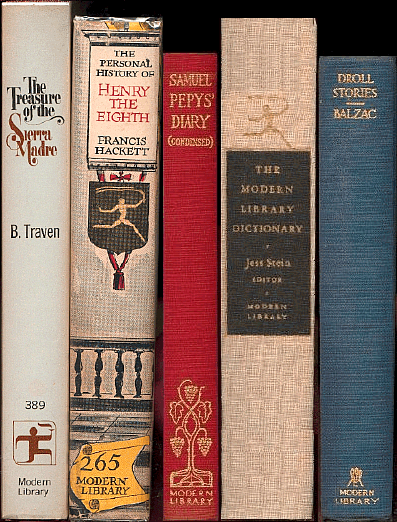
A Plethora of Collecting Options
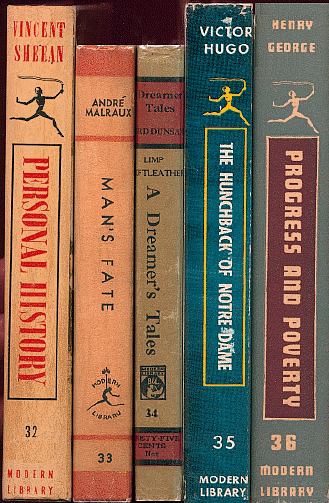
Collecting By the Numbers
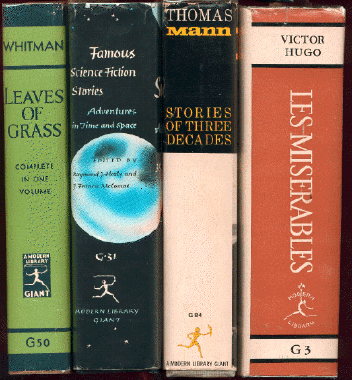
Five Modern Library Giants in Different Jacket Styles
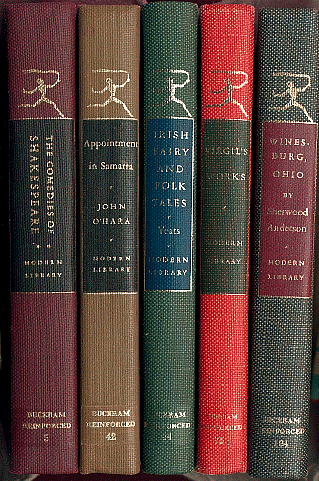
1960's Buckram Editions
In this collecting variation, you'd try to assemble all the titles that came in a particular binding type. The Modern Library used 15 distinct bindings between 1917 and 1970 for its standard issue books (not to mention two for standard buckram issues, one for the illustrated series—two if you include an extra type for those that came in slipcases, seven for the giant issues plus one for the very scarce giant buckrams, and a couple more for special gift editions for a total of nearly 30 binding types).
Several were used for just a few months, a couple for about a year, one was used for about eight years (standard type 7) while another was used for nearly 24 years (standard type 8).
There's no catalog that lists which titles were printed in the shorter-lived bindings, making collecting in those areas especially challenging; you won't know if you're done!
Modern Libraries came in three major dust jacket types: text-only, pictorial, and typographical with design elements. The longer-lived titles had all three types, and some had additional variations. Dostoyevsky's The Brothers Karamazov had at least ten (one text-only, six pictorial, and three illustrated).
Combining dust jacket types with binding types, you could limit your collecting to just the pictorial jackets in the type 7 standard bindings—a particularly alluring challenge because the pictorials of that period (1931 to 1939) were especially beautiful.
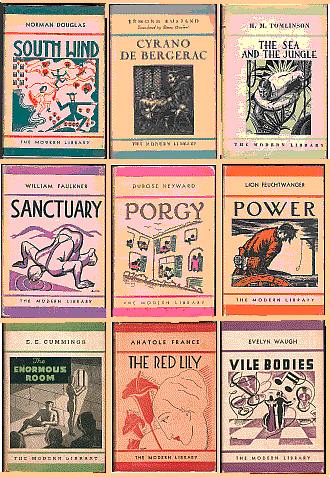
Nine Modern Library Pictorials
This is the toughest area to collect and not for the feint of heart. Enough information exists in the few available reference sources to identify almost all Modern Library first editions along with the characteristics of their appropriately matching dust jackets, but these copies are generally more expensive and less common (and therefore more difficult to come by) than non-first printings.
Even if you have lots of money to spend on first printings, whether you'll ever successfully complete your collection is problematic. This is because no examples of firsts of some of the titles in dust jacket are known to exist. Indeed, finding decent quality dust jackets for any printings before 1925 is extremely difficult, first edition or not. The dust jackets of that era were made of the most ephemeral of papers, and almost all of them have crumbled to dust. (There's a philosophical Truth in there somewhere.)
How much will it cost you?
[:: NOTE: I wrote this article many years ago. The prices listed here are pretty much out of date, but the ratios hold the same -- books with DJs are worth far more than those without, older titles in leatherette with DJs are worth more than most current issues, etc. ::]
You can begin collecting Modern Library titles at less than $8.00 for copies without dust jackets.
Typical prices for non-first common standard edition titles with dust jackets in VG/VG condition (the lowest generally acceptable collecting condition) depend on the period you collect: Expect to pay $15 and up for 1939-1968 stiff cover printings, $18 and up for 1969-1970 printings in the short-lived 7 1/2" format, $30 and up for 1928-1938 copies in flexible bindings, $60 and up for 1925-1928 flexi's, but $100 or more for the earliest period in Boni-Liveright bindings.(Someone recently paid over $300 for a non-first Boni-Liveright copy of #1 Wilde's Picture of Dorian Gray and considered himself lucky.)
Giant editions tend to cost less than comparable standard editions because fewer people collect them.
Expect to pay a substantial premium -- as much as 100% -- for first editions.
Buckram editions, which are never genuine firsts and are never issued with dust jackets, are worth $18 or more a pop in Near Fine condition.
Modern Library Illustrated editions in acetate dust jackets or slipcases command anywhere from $15 for common titles (usually more for acetates than slipcases) to $150 for a Dali-illustrated Don Quixote to at least $400 for Alice in Wonderland.
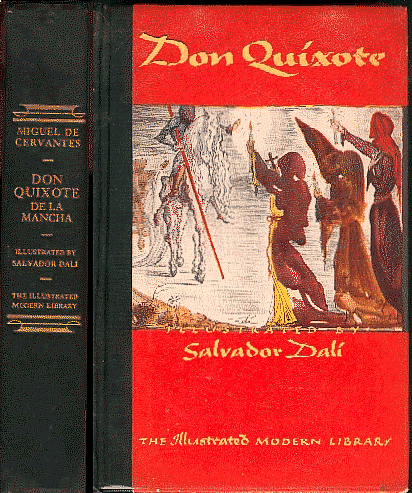
Don Quixote Spine and Front
One day in late November of 1993 I walked into a bookshop on San Francisco's Castro Street looking for a copy of William James' Varieties of Religious Experience. The proprietor, a scholarly looking middle-aged man, told me in a British accent that he had a copy in the Modern Library edition.
"Modern Library? What's that?" I asked skeptically, expecting him to steer me to some absurdly expensive leather-bound tome, when a Penguin paperback would do me nicely. I had just rejected a new copy I found in the Crown Books chain a few doors down that would have set me back $13.95—for a bloody PAPERBACK, for Gawd's sake, plus San Francisco's ruinous 8.5% sales tax. I'd be damned if I'd pay even more in a USED bookstore. (Up to this time I had rejected the concept of buying used books, not wanting who-knows-whose eyetracks cootieing up my books. But I just wanted the James for a quick-and-dirty research project, and $13.95 for a PAPERBACK, well, that just was over the top!)
He pointed to a wall opposite his checkout desk. "About the middle of the wall," he qualified," next to his brother," indicating the neighboring six titles by Henry James. He went back to his paperwork.
The wall was his Modern Library section. It held several hundred copies of books 6 1/2 to 8" tall, most with some variation of a running torchbearer on their spines. There was something familiar about these things, something nostalgic and friendly and strangely attractive.
I took down the James. About seven inches tall and five wide, it fit comfortably in my hands. "This is a nice book," I thought as I leafed through it, noticing the readable type and -- well -- the substantial nature of the thing. It felt like it could last a while -- not something I usually notice or care about.
The price printed on the front flap was $1.65, but written in light pencil on the half-title page was $7.95. "Hrumph," I muttered. "Quite a markup, and it's used at that. Damned booksellers. Worse than coin dealers. It's cheaper than that ripoff paperback, though."
I started to bring the James to the counter when it struck me. These books that were so familiar -- I remembered them from school! I turned back to look at the shelves and was struck by the variety. Novels, short stories, poetry, drama, biography, philosophy, history, politics, essays, art, music, sociology, psychology, religion, and more--nearly the entire gamut of human knowledge.
I turned the James over and read the legend "The Best of the World's Best Books". These were the books I used to buy in prep school and college because they were so cheap. Hard back books at paperback prices.
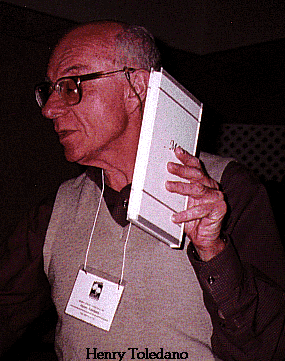
Henry Toledano
I handed the book to the proprietor. "These are becoming quite collectable, you know." No, I didn't know, I said, but I could see how collecting them would make a nice hobby. "I think so," he said, smiling for the first time. "I've written a little book about them," and pointed down to the small pile of privately printed paperbacks in front of the cash register. "The Modern Library Price Guide By Henry Toledano" graced the cover.
I bought the James but passed on the Guide. A week later I bought the guide and spent an additional $75 in Henry Toledano's store on nine more Modern Library books. I was hooked for sure.
Join the party!
With most ML books selling for less than $20/copy in VG/VG condition, collecting the Modern Library series makes a satisfying and inexpensive hobby, and provides a way to build a wonderful library as well—yes, you can actually read what you collect!
For TONS more information about collecting the Modern Library series, including more detailed information on the topics covered in this article, visit my Web site at http://www.ModernLib.com. I'm more than glad to answer your Modern Library questions. (It makes me feel important.) If I don't know the answer, I probably know someone who does.
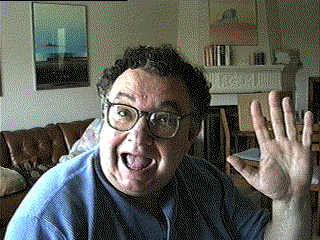
Scot Kamins has been an avid Modern Library collector since 1993. He is the Webmaster of Collecting the Modern Library at www.ModernLib.com, and is the founder of the popular rec.collecting.books newsgroup.
In real life Scot is a contract technical writer living and working in plush but not overly ostentatious surroundings in Portland, Oregon.